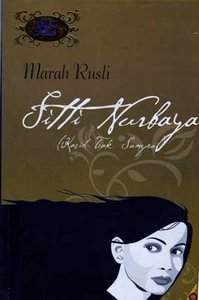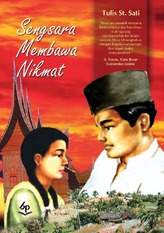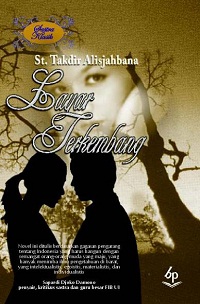Related Research Articles

Djamaluddin Adinegoro was an Indonesian press pioneer. He is known as a reporter, writer, and political analyst. Through his writing in various newspapers, Adinegoro has made a great contribution in developing journalism and the Indonesian language. His name was immortalized as a journalism award in Indonesia: the Adinegoro Award. Djamaluddin was a younger half-brother of Muhammad Yamin.

Indonesian literature is a term grouping various genres of South-East Asian literature.
Balai Pustaka is the state-owned publisher of Indonesia and publisher of major pieces of Indonesian literature such as Salah Asuhan, Sitti Nurbaya and Layar Terkembang. Its head office is in Jakarta.

Pertemuan Jodoh is an Indonesian novel by Abdul Muis originally published in 1932. It tells the story of two students who are driven apart by their class differences, but eventually marry.

Jalan Tak Ada Ujung is an Indonesian novel by Mochtar Lubis first published by Balai Pustaka in 1952. It takes place during the Indonesian war of independence and tells the story of Guru Isa, a schoolteacher who assists the guerrilla freedom fighters yet lives in fear.
Senja di Jakarta is an Indonesian novel written by Mochtar Lubis and first published in English by Hutchinson & Co. in 1963, with a translation by Claire Holt. It was later published in Indonesian in 1970.

Azab dan Sengsara is a 1920 novel written by Merari Siregar and published by Balai Pustaka, Indonesia's major publisher at that time. It tells the story of two lovers, Amiruddin and Mariamin, who are unable to marry and eventually become miserable. It is generally considered the first modern Indonesian novel.

Sitti Nurbaya: Kasih Tak Sampai is an Indonesian novel by Marah Rusli. It was published by Balai Pustaka, the state-owned publisher and literary bureau of the Dutch East Indies, in 1922. The author was influenced by the cultures of the west Sumatran Minangkabau and the Dutch colonials, who had controlled Indonesia in various forms since the 17th century. Another influence may have been a negative experience within the author's family; after he had chosen a Sundanese woman to be his wife, Rusli's family brought him back to Padang and forced him to marry a Minangkabau woman chosen for him.

Sengsara Membawa Nikmat is an Indonesian novel written by Tulis Sutan Sati. It was published in 1929 by Balai Pustaka. It tells the story of Midun, the son of a farmer, who experiences many trials before finally living happily with his new wife. It has been noted as one of Sati's most interesting works.

Layar Terkembang is an Indonesian novel by Sutan Takdir Alisjahbana. Published in 1936 or 1937 by Balai Pustaka, it tells the story of two sisters and their relationship with a medical student. It has been noted as emphasizing the need for Indonesians to adopt Western values in order to modernize the country.

Belenggoe is a novel by Indonesian author Armijn Pane. The novel follows the love triangle between a doctor, his wife, and his childhood friend, which eventually causes each of the three characters to lose the ones they love. Originally published by the literary magazine Poedjangga Baroe in three instalments from April to June 1940, it was the magazine's only published novel. It was also the first Indonesian psychological novel.

Poedjangga Baroe was an Indonesian avant-garde literary magazine published from July 1933 to February 1942. It was founded by Armijn Pane, Amir Hamzah, and Sutan Takdir Alisjahbana.

Atheis is a 1949 Indonesian novel written by Achdiat Karta Mihardja and published by Balai Pustaka. The novel, using three narrative voices, details the rise and fall of Hasan, a young Muslim who is raised to be religious but winds up doubting his faith after dealings with his Marxist–Leninist childhood friend and an anarcho-nihilist writer.

Bakri Siregar was an Indonesian socialist literary critic and writer.
Darah Muda is a 1927 novel written by Indonesian writer Djamaluddin Adinegoro and published by Balai Pustaka. It is one of few Indonesian novels from the period in which the protagonists succeed in love.

Dian jang Ta' Koendjoeng Padam is a 1932 novel by Sutan Takdir Alisjahbana. It was published by Balai Pustaka.

Di Bawah Lindungan Ka'bah is the 1938 debut novel of the Indonesian author Haji Abdul Malik Karim Amrullah (1908–1981). Written while the author worked in Medan as the editor of an Islamic weekly magazine, the novel follows the doomed romance of a young Minang couple from different social backgrounds. Generally praised for its simple yet eloquent diction, the novel has been twice adapted into film, first in 1977 and then in 2011.

Tenggelamnja Kapal van der Wijck is an Indonesian serial and later novel by Haji Abdul Malik Karim Amrullah published in 1938. It follows the failed love between Zainuddin, a mixed-race man, and Hayati, a pure Minang woman.

Sariamin Ismail was the first female Indonesian novelist to be published in the Dutch East Indies. A teacher by trade, by the 1930s she had begun writing in newspapers; she published her first novel, Kalau Tak Untung, in 1933. She published two novels and several poetry anthologies afterwards, while continuing to teach and – between 1947 and 1949 – serving as a member of the regional representative body in Riau. Her literary works often dealt with star-crossed lovers and the role of fate, while her editorials were staunchly anti-polygamy. She was one of only a handful of Indonesian women authors to be published at all during the colonial period, alongside Fatimah Hasan Delais, Saadah Alim, Soewarsih Djojopoespito and a few others.

Kalau Ta' Oentoeng is a 1933 novel written by Sariamin Ismail under the pseudonym Selasih. It was the first Indonesian novel written by a woman. Written in a flowing style heavily dependent on letters, the novel tells the story of two childhood friends who fall in love but cannot be together. It was reportedly based on the author's own experiences. Although readings have generally focused on the novel's depiction of an "inexorable fate", feminist and postcolonial analyses have also been done.
References
- Footnotes
- ↑ Mahayana, Sofyan & Dian 1995, p. 12.
- 1 2 3 Jakarta City Government, Adinegoro.
- ↑ Balfas 1976, p. 56.
- ↑ Siregar 1964, p. 46.
- ↑ Mahayana, Sofyan & Dian 1995, p. 17.
- 1 2 Teeuw 1980, p. 92.
- ↑ Mahayana, Sofyan & Dian 1995, p. 16.
- ↑ Retnaningsih 1983, p. 98-99.
- Bibliography
- Balfas, Muhammad (1976). "Modern Indonesian Literature in Brief". In Brakel, L. F. (ed.). Handbuch der Orientalistik [Handbook of Orientalistics]. Vol. 1. Leiden, Netherlands: E. J. Brill. ISBN 978-90-04-04331-2.
- "Adinegoro". Encyclopedia of Jakarta (in Indonesian). Jakarta City Government. Archived from the original on 31 May 2012. Retrieved 6 April 2012.
- Mahayana, Maman S.; Sofyan, Oyon; Dian, Achmad (1995). Ringkasan dan Ulasan Novel Indonesia Modern [Summaries and Commentary on Modern Indonesian Novels] (in Indonesian). Jakarta: Grasindo. ISBN 978-979-553-123-4.
- Retnaningsih, Aning (1983). Roman dalam Pertumbuhan Kesusastraan Indonesia Modern[The Novel in the Development of Modern Indonesian Literature] (in Indonesian). Vol. revised. Jakarta: Erlangga. OCLC 251685885.
- Siregar, Bakri (1964). Sedjarah Sastera Indonesia [History of Indonesian Literature] (in Indonesian). Vol. 1. Jakarta: Akademi Sastera dan Bahasa "Multatuli". OCLC 63841626.
- Teeuw, A. (1980). Sastra Baru Indonesia [New Indonesian Literature] (in Indonesian). Vol. 1. Ende: Nusa Indah. OCLC 222168801.